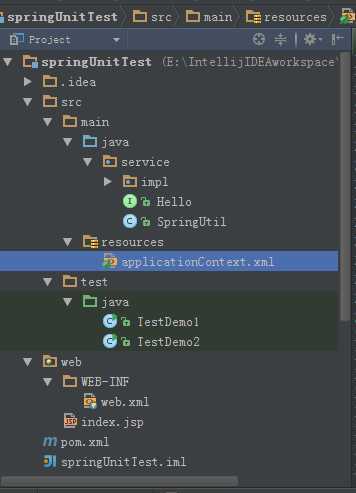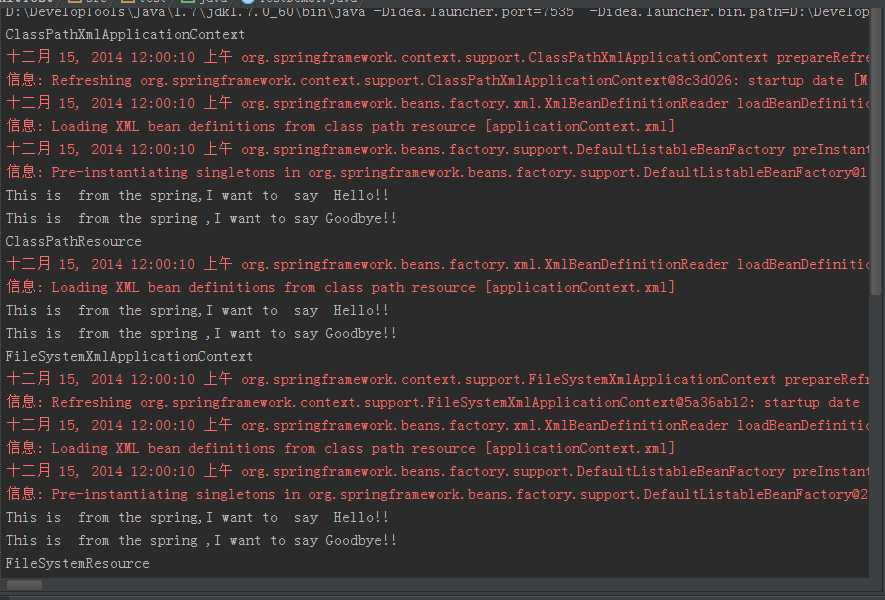标签:style blog http io ar color 使用 sp java
我们知道IOC容器时Spring的核心,可是如果我们要依赖IOC容器对我们的Bean进行管理,那么我们就需要告诉IOC容易他需要管理哪些Bean而且这些Bean有什么要求,这些工作就是通过通过配置文件告诉Spring 的IOC容器。在我们的完成这些配置文件以后,如果IOC容易要实现对这些Bean的管理,除了资源的定位还有一个很重要的一步就是完成IOC加载初始化,也就是配置文件的载入过程。完成IOC容器加载初始化的方式只要有三种,第一种就是通过File文件加载,第二种是通过Classpath(相对路径)加载,还有一种就是通过web引入的方式。我们分别做简单的 介绍。
在介绍通过文件方式加载之前我们首先写一些简单的测试案例
A:项目布局

B:测试主要用到的类和接口:
接口Hello.java
package service;
public interface Hello {
public void sayHello();
public void sayGoodbye();
}
接口实现:HelloImpl.java
package service.impl;
import service.Hello;
public class HelloImpl implements Hello {
@Override
public void sayHello() {
System.out.println("This is from the spring,I want to say Hello!!");
}
@Override
public void sayGoodbye() {
System.out.println("This is from the spring ,I want to say Goodbye!!");
}
}
C:spring相关配置文件(spring的默认配置文件位于WEB-INF文件夹中的applicationContext.xml)
<?xml version="1.0" encoding="UTF-8"?> <beans xmlns="http://www.springframework.org/schema/beans" xmlns:xsi="http://www.w3.org/2001/XMLSchema-instance" xmlns:context="http://www.springframework.org/schema/context" xmlns:tx="http://www.springframework.org/schema/tx" xmlns:aop="http://www.springframework.org/schema/aop" xsi:schemaLocation="http://www.springframework.org/schema/beans http://www.springframework.org/schema/beans/spring-beans-3.2.xsd http://www.springframework.org/schema/context http://www.springframework.org/schema/context/spring-context-3.2.xsd http://www.springframework.org/schema/mvc http://www.springframework.org/schema/mvc/spring-mvc.xsd http://www.springframework.org/schema/tx http://www.springframework.org/schema/tx/spring-tx-3.2.xsd http://www.springframework.org/schema/aop http://www.springframework.org/schema/aop/spring-aop-3.2.xsd "> <bean id="hello" class="service.impl.HelloImpl"/> <bean id="springUtil" class="service.SpringUtil"/> </beans>
D:通过FileSystemXmlApplicationContext加载
/*FileSystemXmlApplicationContext加载方式*/
FileSystemXmlApplicationContext fileSystemXmlApplicationContext = new FileSystemXmlApplicationContext("classpath:applicationContext.xml");
Hello hello2 = (Hello) context.getBean("hello");
hello2.sayHello();
hello2.sayGoodbye();
E:通过FileSystemResource方式加载
/*FileSystemResource加载方式*/
BeanFactory factory2 = new XmlBeanFactory(new FileSystemResource("E:\\WorkSpace\\IntellijIDEAworkspace\\springFunctions\\ManvenSpringTest\\src\\main\\resources\\applicationContext.xml"));
Hello hello4= factory2.getBean("hello",Hello.class);
hello4.sayHello();
hello4.sayGoodbye();
F:(FileSystemXmlApplicationContext)其他说明
1.默认为项目工作路径 即项目的根目录
ApplicationContext appCt2 = new FileSystemXmlApplicationContext("src/main/resources/XXXXXX.xml");
2.前缀classpath:表示的是项目的classpath下相对路径
ApplicationContext appCt2 = new FileSystemXmlApplicationContext("classpath:XXXXxml");
3.使用前缀file 表示的是文件的绝对路径
ApplicationContext appCt2 = new FileSystemXmlApplicationContext("file:D:/XXXX.xml");
ApplicationContext appCt2 = new FileSystemXmlApplicationContext("D:/XXXX.xml");
4.可以同时加载多个文件
String[] xmlCfg = new String[] { "src/main/resources/XXXXX.xml","classpath:YYYY.xml"};
ApplicationContext appCt2 = new FileSystemXmlApplicationContext(xmlCfg);
5.使用通配符加载所有符合要求的文件
ApplicationContext appCt2 = new FileSystemXmlApplicationContext("classpath:*.xml");
A:所使用的文件如果上面一致
B:通过ClassPathXmlApplicationContext加载
/*ClassPathXmlApplicationContext加载方式*/
ClassPathXmlApplicationContext context = new ClassPathXmlApplicationContext("classpath:applicationContext.xml");
Hello hello = (Hello) context.getBean("hello");
hello.sayHello();
hello.sayGoodbye();
C:通过ClassPathResource方式加载
/*ClassPathResource加载方式*/
BeanFactory factory = new XmlBeanFactory(new ClassPathResource("applicationContext.xml"));
Hello hello3= factory.getBean("hello",Hello.class);
hello3.sayHello();
hello3.sayGoodbye();
D:其他说明
1.没有前缀:默认为项目的classpath下相对路径
ApplicationContext appCt = new ClassPathXmlApplicationContext("XXXX.xml");
2.前缀classpath:表示的是项目的classpath下相对路径
ApplicationContext appCt = new ClassPathXmlApplicationContext("classpath:YYYY.xml");
3.使用前缀file 表示的是文件的绝对路径
ApplicationContext appCt = new ClassPathXmlApplicationContext("file:D:/XXXX.xml");
4.可以同时加载多个文件
String[] xmlCfg = new String[] { "classpath:XXX.xml","YYYY.xml"};
ApplicationContext appCt = new ClassPathXmlApplicationContext(xmlCfg);
5.使用通配符加载所有符合要求的文件
ApplicationContext appCt = new ClassPathXmlApplicationContext("*.xml");
WEb方式加载
A:这个需要通过配置ContextLoaderListener
<!-- 指定Spring Bean的配置文件所在目录。默认配置在WEB-INF目录下 -->
<context-param>
<param-name>contextConfigLocation</param-name>
<param-value>classpath*:/applicationContext.xml</param-value>
</context-param>
<listener>
<listener-class>org.springframework.web.context.ContextLoaderListener</listener-class>
</listener>
B:这样就可以将IOC容器加载到环境中了。
执行结果
代码:TestDemo1.java
import org.springframework.beans.factory.BeanFactory;
import org.springframework.beans.factory.xml.XmlBeanFactory;
import org.springframework.context.support.ClassPathXmlApplicationContext;
import org.springframework.context.support.FileSystemXmlApplicationContext;
import org.springframework.core.io.ClassPathResource;
import org.springframework.core.io.FileSystemResource;
import service.Hello;
public class TestDemo1 {
public static void main(String []args){
System.out.println("ClassPathXmlApplicationContext");
/*ClassPathXmlApplicationContext加载方式*/
ClassPathXmlApplicationContext context = new ClassPathXmlApplicationContext("classpath:applicationContext.xml");
Hello hello = (Hello) context.getBean("hello");
hello.sayHello();
hello.sayGoodbye();
System.out.println("ClassPathResource");
/*ClassPathResource加载方式*/
BeanFactory factory = new XmlBeanFactory(new ClassPathResource("applicationContext.xml"));
Hello hello3= factory.getBean("hello",Hello.class);
hello3.sayHello();
hello3.sayGoodbye();
System.out.println("FileSystemXmlApplicationContext");
/*FileSystemXmlApplicationContext加载方式*/
FileSystemXmlApplicationContext fileSystemXmlApplicationContext = new FileSystemXmlApplicationContext("classpath:applicationContext.xml");
Hello hello2 = (Hello) fileSystemXmlApplicationContext.getBean("hello");
hello2.sayHello();
hello2.sayGoodbye();
System.out.println("FileSystemResource");
/*FileSystemResource加载方式*/
BeanFactory factory2 = new XmlBeanFactory(
new FileSystemResource("E:\\WorkSpace\\IntellijIDEAworkspace\\springFunctions\\ManvenSpringTest\\src\\main\\resources\\applicationContext.xml"));
Hello hello4= factory2.getBean("hello",Hello.class);
hello4.sayHello();
hello4.sayGoodbye();
}
}
运行结果:

上面的测试用例都是采用最原来的凡是来实现的,这样对于做项目来说就是不专业的也是效率低下的。Spring自己提供了单元测试的相关支持,通过这个我们可以极大地优化我们的测试用例,下篇文章做个总结和说明。
标签:style blog http io ar color 使用 sp java
原文地址:http://www.cnblogs.com/zhangminghui/p/4164011.html